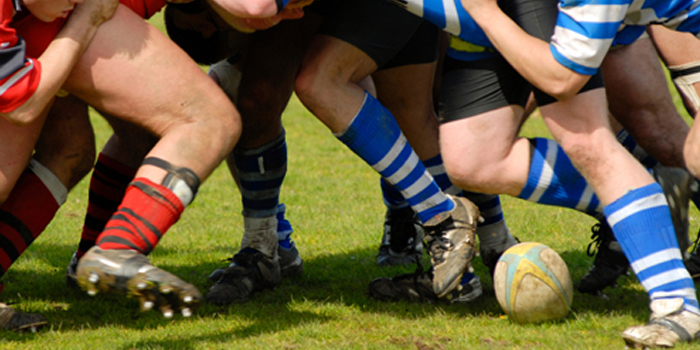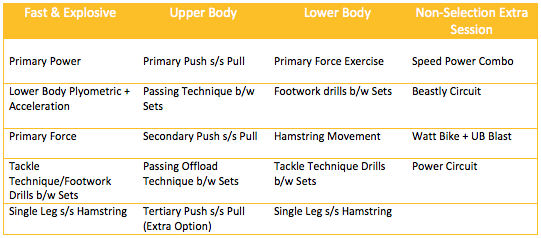
Size matters, especially if you're a down lineman or a prop forward. The difference between the two sports is more involved, with aerobic demands placed on the props in rugby. We expect them to be able to run a 17.1 yoyo test result. However, irrespective of these two groups, the majority of players will benefit from strength training and the resultant game specific size increases rather than a specific hypertrophy protocol, which may be used with the other 20 percent of the team, namely props and down linemen.
To this end, I would like to detail a weight room strategy that you may find useful in developing the strength and size of your team. Previously, I've dealt with the power-related training protocols that I believe produce the best results in this area. The majority of rugby weekly plans that I've seen usually do some form of power training on a game day -1 or -2. This seems to be the norm across the rugby world.
I believe that contrast training is ideal for this training day. The volume isn't high, but the intensity is ramped up. I also believe that the work of Bryan Mann on velocity-based training (VBT) is extremely important to get the most out of this training session so that the weekly plan produces a successful outcome on game day.
This is a program that I've used regularly on this day of the week:
- Olympic or band assisted deadlift or power tackler X 1
- Band assisted squat or weight release squat or band/chain resisted box squat X 1
- Push press or split jerk or hammer jammer or hammer push/pull X 1
- Heavy power, 3–8 sets X 3 reps at loading >80%
- Light power, 2–4 sets X 6–8 reps at loading 40–60%
And this is what I'm currently using now:
- Peak power exercise of your choice per the loading chart below and/or VBT supersetted with 10-meter accelerations with loaded sleds/Prowler contrasted with unloaded sprint
- Lower body plyometric options of your choice [same reps as loading chart (knees to feet jumps/box jumps/repeat hurdle jumps/Borzov hops/depth jumps)]
- Speed-strength: 0.8 to 1.0 meters per second
- Strength-speed: 0.6 to 0.7 meters per second
- Power snatch: 1.50 meters per second (in reference to the modified Olympic lifts)
- Power clean: 1.25 meters per second (in reference to the modified Olympic lifts)
Strength Training
Now let's move to the elements of the strength training program that I believe will produce game-specific usable strength as well as the additional size protocols for those players who you think will benefit.
Please select one of the following from the warm-up sheet (high hurdle mobility circuit, plate circuit, body weight circuit, skip plus kettlebell, kettlebell circuit, dumbbell shoulder circuit, Olympic complex, limber 11)plus any specific prehabilitation/rehabilitation exercise as given to you by the medical staff.
Main course
Dessert
Neck plus core plus choose one finishing movement or combination to complete the workout.
Core Options
Suitcase deadlifts, Zercher lifts, half Turkish get-ups, band rotations, wipers (choose three exercises and perform 3 sets X 5 reps).
Finishing Movements
Matrix shoulders (plate front raise supersetted with plate Liu lateral raises), matrix bar curls supersetted with triceps death, triple drop bench supersetted with triple angle chins, push-ups with chains drop set, YTIs tri set, three-way shoulder raises.
Weight Training Warm-Up
“If you do not have time to warm up properly, you do not have enough time to train!”
1. High hurdle mobility circuit: Forward and backward, over and under
2. Plate circuit (6 reps each movement) X 3: Plate swings, overhead squats, plate head circles, plate horizontal pushes, plate wood chops, alternating reverse lunges with twist, plate bent over rows
3. Body weight combat conditioning circuit (10 reps each movement): Grasshoppers, mountain climbers, Hindu push-ups, side to side squats, prone scorpions, alternating diagonal lunges, reverse push-ups, rock & rolls, no momentum sit-ups, legs to floor overhead
4. Skipping plus kettlebell swings, 30 seconds each X 10
5. Kettlebell circuit (6 reps each exercise) X 3: Turkish get-up, MMA rows, MMA presses, alternating upright rows, see saw shoulder presses, swing and & catches
6. Dumbbell shoulder circuit (10 reps each movement): Arnold presses, lateral raises, front raises, bent over raises, YTIs, drawing the swords, L raises, Cuban presses, overhead shrugs, scarecrows
7. Olympic lifting complex, bar only (6 reps of each movement) X 3:
- Muscle snatches from the floor, hang power snatches, snatch balances, snatch squat presses, overhead squats
- Clean grip power snatches, hang power cleans, front squats, sots presses, push presses
- Hang snatches, push presses, front squats, hang cleans, bent over rows, Romanian deadlifts
8. DeFranco's Limber 11
In conclusion, programming is a living document. I welcome your thoughts and ideas so that we can all grow. We must strive to meet the needs of our players so that they can achieve the goals they're striving for. We also need to ensure that we have the correct processes in place to allow the team to play the game that the head coach wants to implement.

















Loving your work, mate. Hopefully we can get some more discussions going. I have a couple of questions. I know you group your hookers with the loosies as far as fitness goes. I would assume for strength training, with a couple of modifications, they'd be following something this similar.
My ultimate question is do you use a "strong enough" line of thinking? There's obviously going to be a delicate balance between achieving optimal fitness and strength/power. Obviously as a forward, strength matters. You've talked about the "strong enough" thing for the backs, I imagine it's a bit trickier for the forwards?
Cheers
1. Horizontal Chins is a exercise for back, at first place. Beside that, for which group of muscles can I do that exercise? Rear Delts maybe?
2. I achieved the aerobic fitness level I wanted. Now I would like to improve leg strength and explosiveness, and I still need to work Upper Body Size, without losing my weight. Can my training programs look like this:
monday:speed,heavy lower body power+upper body size
tuesday:off
wednesday:conditioning,full body strength
thursday:off
friday:speed,light lower body power+upper body size
saturday:conditioning
sunday:off?
Trap Bar Deadlift 2.5xBW
Deadlift 2BW
Back Squat 2BW
Front Squat 1.75BW
Bench Press 1.5BW
Incline Bench Press 1.25BW
Power Clean 1.25BW
Jerk/Push Press 1.25BW
Power Snatch BW
Military Press BW